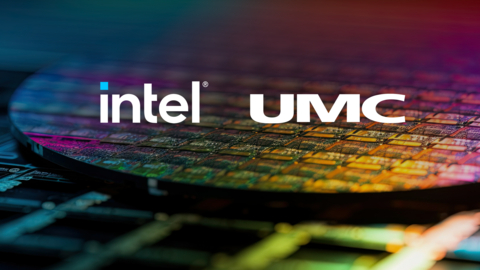Intel and UMC Announce New Foundry Collaboration
NEWS HIGHLIGHTS
- Companies to collaborate on the development of a 12-nanometer process platform targeting high-growth markets.
-
Collaboration builds on Intel’s commitment to partnering with innovative companies in
Taiwan to help the company better serve global customers and expand its mature process capabilities for foundry customers. - Deal broadens customer access to a geographically diverse semiconductor supply chain.
- Collaboration provides UMC with additional capacity, accelerates its development roadmap and demonstrates its leading process technology R&D.

Intel Corp. and United Microelectronics Corp. announce that they will collaborate on the development of a 12-nanometer semiconductor process platform to address high-growth markets. (Credit: Intel Corporation)
“Taiwan has been a critical part of the Asian and global semiconductor and broader technology ecosystem for decades, and Intel is committed to collaborating with innovative companies in
Jason Wang, UMC co-president, said, “Our collaboration with Intel on a
The 12 nm node will utilize Intel’s
The two companies will work to satisfy customer demand and cooperate on design enablement to support the 12 nm process by enabling electronic design automation and intellectual properties solutions from ecosystem partners. Production of the 12 nm process is expected to begin in 2027.
Intel has been investing and innovating in the
UMC has a more than 40-year history of being a preferred supplier of foundry services to critical applications including automotive, industrial, display and communications. Over the past two decades, UMC has successfully expanded its base across
Forward-Looking Statements
This communication contains certain forward-looking statements related to the proposed transactions between Intel and UMC and certain of their affiliates, including statements regarding the benefits and the timing of the transactions. Words such as “expect,” “plan” and “will” and variations of such words and similar expressions are intended to identify such forward-looking statements. Such statements are based on management expectations as of the date of this communication and involve risks and uncertainties, many of which are beyond the parties’ control, that could cause actual results to differ materially from those expressed or implied in such forward-looking statements. Such risks and uncertainties include, among others, business interruptions related to the supply chains of Intel and UMC; inability to develop or sell products successfully under the collaboration between Intel and UMC; delays, disruptions, challenges or increased costs in Intel’s or UMC’s construction or manufacturing expansion of fabs, whether due to events within or outside of Intel’s or UMC’s control; expected benefits, including financial benefits, of the transactions may not be realized; litigation or dispute related to the transactions or otherwise; unanticipated costs may be incurred or undisclosed liabilities assumed; risks related to diverting management’s attention from Intel’s or UMC’s ongoing business operations; UMC’s ability to develop and execute an effective and profitable go-to-market strategy; potential adverse reactions or changes to business relationships (including customers and suppliers) resulting from the announcement of the transaction; macroeconomic conditions, including the general economic conditions affecting the semiconductor industry; regulatory restrictions; impact of competitive products and pricing; hiring and retention of key employees; international conflict; and other risks detailed in Intel’s filings with the Securities and Exchange Commission (the “SEC”), including those discussed in Intel’s most recent Annual Report on Form 10-K and in any subsequent periodic reports on Form 10-Q and Form 8-K, and in UMC’s most recent Annual Report on Form 20-F and in any subsequent periodic reports on Form 6-K, each of which is on file with or furnished to the SEC and available at the SEC’s website at www.sec.gov. SEC filings for Intel are also available on Intel’s Investor Relations website at www.intc.com. SEC filings for UMC are also available on UMC’s Investor Relations website at www.UMC.com. Readers are cautioned not to place undue reliance on these forward-looking statements, which speak only as of the date of this communication. Unless otherwise required by applicable law, Intel and UMC undertake no obligation to update these forward-looking statements, whether as a result of new information, future events or otherwise.
About Intel
Intel (Nasdaq: INTC) is an industry leader, creating world-changing technology that enables global progress and enriches lives. Inspired by Moore’s Law, we continuously work to advance the design and manufacturing of semiconductors to help address our customers’ greatest challenges. By embedding intelligence in the cloud, network, edge and every kind of computing device, we unleash the potential of data to transform business and society for the better. To learn more about Intel’s innovations, go to newsroom.intel.com and intel.com.
About UMC
UMC (NYSE: UMC, TWSE: 2303) is a leading global semiconductor foundry company. The company provides high-quality IC fabrication services, focusing on logic and various specialty technologies to serve all major sectors of the electronics industry. UMC’s comprehensive IC processing technologies and manufacturing solutions include Logic/Mixed-Signal, embedded High-Voltage, embedded Non-Volatile-Memory, RFSOI, BCD etc. Most of UMC's 12-in and 8-in fabs with its core R&D are in
© Intel Corporation. Intel, the Intel logo and other Intel marks are trademarks of Intel Corporation or its subsidiaries. Other names and brands may be claimed as the property of others.
View source version on businesswire.com: https://www.businesswire.com/news/home/20240124594394/en/
Michael Anderson
Intel Investor Relations
1-916-356-7704
michael.d.anderson@intel.com
Sophie Won
Intel Media Relations
1-408-653-0475
sophie.won@intel.com
Jolie Chiu
UMC
886-3-578-2258 x31318
jolie_chiu@umc.com
Source: Intel Corp.







